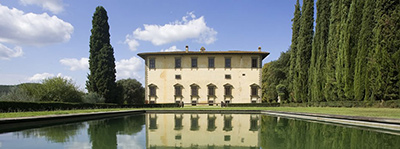The simplicity of the design of Villa I Collazzi enhances the majestic villa’s historic prestige. The styling is attributed to renaissance artist Michelangelo Buonarroti whose architectural designs are as good as his paintings and sculptures.
Villa I Collazi changed hands several times over the centuries. It used to be a fortress that was owned by Buondelmonte. In 1534 it was bought by bankers, Baccio and Agostino Bini, who commissioned Michelangelo and Augostino Dini to transform it into a spectacular villa.
Although Michelangelo is credited for the works, some historians doubt if the two took part in the renovations. It is, however, documented that Michelangelo was active in Florence at that time when he also designed a different villa with a similar design.
In the 18th century, Castelli Media, the wife of Bini, enlarged and embellished the Villa. She designed the double stair case at the entry in 1754. The important painting in the chapel was placed there in 1593.
The Bombicci family planted cypress trees in a circle of the terrace in 1853. The Marchi family purchased the property in 1933 and made it complete by incorporating the pool designed by Pietro Porcinai in 1938.
The architectural improvements made over the years make this villa one of the most striking and well preserved historical properties in Florence. It is now used as a vacation home. The villa is currently managed by the Marchi family who run a farm and winery business.
St. Peters Basillica
This majestic church is built on St. Peter’s, burial site.
Its size and location speaks of the importance of the basilica which is the best architectural works of Michelangelo. Although its construction began in 1506, the works continued for a long time because Pope Julius II wanted an enormous church showcasing the height of architecture in Rome.
Many architects worked on the building which was based on Donato Bramante’s design.
Michelangelo started working on it in 1547 perfecting earlier designs by removing excessive ornamentation and applying painting and sculpting principles to create a more beautiful and grandeur basilica.
He also made most of the improvements on the exterior of the building. Like designer Bramate, he divided the exterior into many parts using double pilasters. However, the units that he used weren’t uniform in size and doubled the size of the pilasters.
Their vertical reach extends to the dome of the church which is 452 feet high, the tallest dome in the world. It is also one of the most celebrated and copied domes ever built. He put a lot of effort on the dome more than any other part of the basilica.
It summarizes the entire history of the church. Although Michelangelo died before the church was completed, the architect who took over continued to build it according to the designs of Michalengelo.
Other buildings designed by Michelangelo
Basilica di San Lorenzo: This complex consists of chapels, a library and additional important structures. The Medici family wanted to build the majestic basilica to showcase a new architecture design. Since they had a close relationship with Michelangelo, they commissioned him to design library churches and the New Sacristy section of the chapels.
He created the New Sacristy to accommodate tombs of members of the Medici Family. The design of the library was important because it was supposed to celebrate knowledge. Working over another structure and limited by designs from other buildings he was able to produce natural proportions.
Capitoline Hill in Rome: Michelangelo completely redesigned Capitoline Hill and surrounding buildings resulting into Piazza del Campidoglio. He began the construction by designing a focal point between three buildings. A bronze statue of Roman Emperor Marcus Aurelius stands at the centre of the courtyard.
Farnese Palace: He began working on this square, standalone building in 1546 after the death of Antonio Da Sangallo, its original architect. Michelangelo’s expert completion of the palace showed his aptitude to work on incomplete buildings. He created windows that not only complemented but also surpassed the original designer’s.
Santa Maria degli Angeli (1563-64): This design involved transforming ruins of the Roman Baths of Diocletian into a church. Before the transformation, the enormous interior was covered with marble of different colours and pagan status. Michelangelo utilised the expansive space of the church.
Conclusion
Michelangelo architectural works continue to impress many. His designs are a mix of mannerist architecture and free approach to structural form. His ability to offset effect of perspective is demonstrated by the shape of Rome’s Capitoline Hill. Although he ventured into architecture when he was older, he used his artistic expertise to design works that defined convention of that time.


